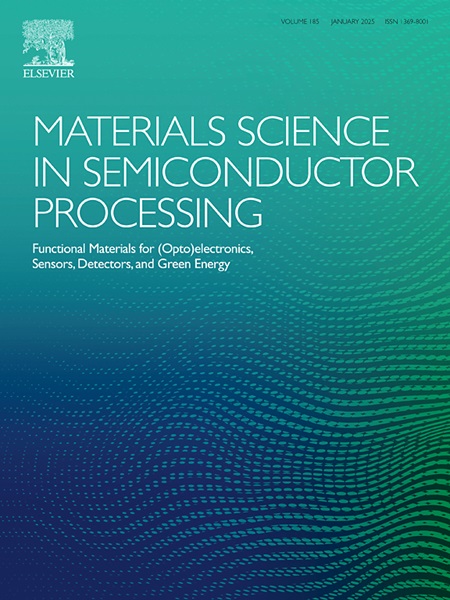用于潜光 LED 和高安全性荧光防伪油墨的 Dy3+ 的修正多模态光学特性
IF 4.6
3区 工程技术
Q2 ENGINEERING, ELECTRICAL & ELECTRONIC
引用次数: 0
摘要
通过低温燃烧法,在 1173 K - 4 小时内合成了钛酸二钇镁的双过氧化物,与传统方法相比,热预算减少了 625 K - 5 小时。根据紫外-可见光谱,带隙为 3.653 eV。晶格中掺杂了一系列 Dy3+ 离子,在 353 纳米激发波长下发出纯白色光,在 980 纳米激发波长下发出红色光。晶体结构由 FESEM 和拉曼分析证实。XPS 分析表明,最佳元素掺杂量为 2 wt%,而 TGA 分析表明,在极端热条件下,荧光粉仍然保持稳定。在晶体基质中进一步共掺入一价 Li+、二价 Sr2+ 或三价 Sm3+ 离子,主要是为了增强 Li+敏化的晶体、光学和发光特性。这些 CIE 参数被修正为理想白光,坐标为 (0.326,0.333),色温为 5819 K,色纯度为 2.5%,标志着一种新型理想白光发射。由于荧光粉在近红外激发下会发出红光,因此使用 PVA 制备的防伪油墨具有独特的双波长荧光印刷油墨技术,可解决严重的伪造问题。本文章由计算机程序翻译,如有差异,请以英文原文为准。
Amended multimodal optical properties of Dy3+ for Latent wLED and high-security fluorescence anti-counterfeiting ink
Double perovskites of diyttrium magnesium titanate are synthesized by low-temperature combustion method at 1173 K - 4 h, marking a decrease in thermal budget 625 K - 5 h with conventional practice. From the UV–visible spectra, the bandgap is obtained as 3.653 eV. A series of Dy3+ ions are doped in the crystal lattice giving pure white emission at 353 nm excitation and red emission at 980 nm excitation. The crystal structure is confirmed by FESEM and Raman analysis. The optimal 2 wt% elemental doping is inveterate from the XPS analysis whereas the phosphors remain stable under extreme thermal conditions, realized from the TGA. Further monovalent Li+, divalent Sr2+, or trivalent Sm3+ ions are co-doped in the crystal matrix, which chiefly enhances the crystalline, optical, and luminescence properties for Li+ sensitization. These CIE parameters are amended to ideal white light with coordinates (0.326, 0.333), color temperature of 5819 K, and color purity of 2.5 %, signifying a novel ideal white light emission. Anti-counterfeit inks are prepared using PVA due to the red emission of the phosphor under NIR excitation, distinctive for double wavelength fluorescence printing ink technique to tackle serious counterfeiting.
求助全文
通过发布文献求助,成功后即可免费获取论文全文。
去求助
来源期刊

Materials Science in Semiconductor Processing
工程技术-材料科学:综合
CiteScore
8.00
自引率
4.90%
发文量
780
审稿时长
42 days
期刊介绍:
Materials Science in Semiconductor Processing provides a unique forum for the discussion of novel processing, applications and theoretical studies of functional materials and devices for (opto)electronics, sensors, detectors, biotechnology and green energy.
Each issue will aim to provide a snapshot of current insights, new achievements, breakthroughs and future trends in such diverse fields as microelectronics, energy conversion and storage, communications, biotechnology, (photo)catalysis, nano- and thin-film technology, hybrid and composite materials, chemical processing, vapor-phase deposition, device fabrication, and modelling, which are the backbone of advanced semiconductor processing and applications.
Coverage will include: advanced lithography for submicron devices; etching and related topics; ion implantation; damage evolution and related issues; plasma and thermal CVD; rapid thermal processing; advanced metallization and interconnect schemes; thin dielectric layers, oxidation; sol-gel processing; chemical bath and (electro)chemical deposition; compound semiconductor processing; new non-oxide materials and their applications; (macro)molecular and hybrid materials; molecular dynamics, ab-initio methods, Monte Carlo, etc.; new materials and processes for discrete and integrated circuits; magnetic materials and spintronics; heterostructures and quantum devices; engineering of the electrical and optical properties of semiconductors; crystal growth mechanisms; reliability, defect density, intrinsic impurities and defects.
 求助内容:
求助内容: 应助结果提醒方式:
应助结果提醒方式:


